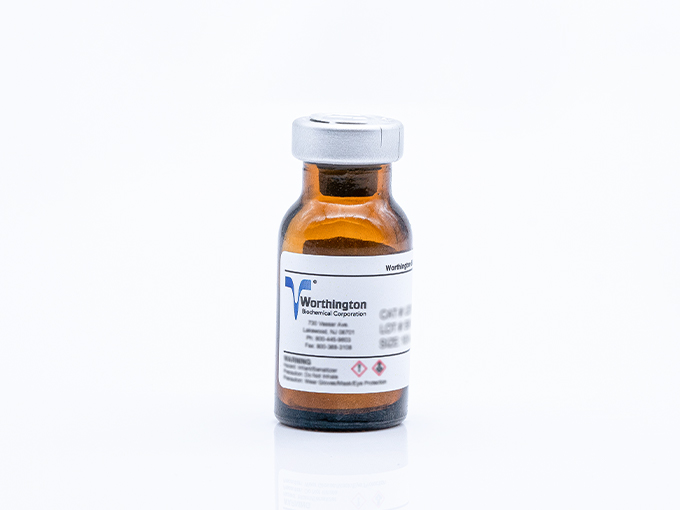Papain & Trypsin
Papain & Trypsin for Cell Isolation
Papain and Trypsin are proteolytic enzymes commonly used for tissue dissociation in various biomedical and research applications.
Papain
Papain, a cysteine protease derived from the papaya fruit (Carica papaya), is widely used in tissue dissociation procedures. It cleaves peptide bonds in proteins, particularly those adjacent to amino acids with large hydrophobic side chains. Due to its gentle proteolytic activity and broad substrate specificity, it is very effective in breaking down extracellular matrix proteins while preserving the integrity and viability of the cells.
Papain is well suited to be used in combination with other enzymes, like Collagenase, Dispase or Trypsin, depending on experimental needs.
Request your digital copy of Worthingtons’ Tissue Dissociation Guide from us o receive valuable insights on optimizing your protocols.
Trypsin
Trypsin is a pancreatic serine protease. It cleaves peptide bonds on the carboxyl side of lysine and arginine residues. Trypsin is commonly used for isolating primary cells from tissues. While purified Trypsin alone is generally ineffective due to its limited selectivity for extracellular proteins, combining it with other enzymes like Elastase or Collagenase has shown effective dissociation.
Trypsin is frequently useded to detach adherent cells from tissue culture surfaces for cell harvesting in the context of cell propagation. Therefore, our product portfolio includes purified Trypsin ( Code: TL, TRL, TRLS, and TRLVMF) and ready-to-use Trypsinization Kits, which are also available xeno-free.
Trypsin Inhibitors
Trypsin inhibitors are commonly used to control the activity of trypsin and other proteolytic enzymes during the tissue dissociation process. Trypsin Inhibitors from soybean or lima bean inactivate trypsin on an equimolar basis. Most widely used is the inhibitor from soybean, which also inhibits Chemotrypsin. The soybean and lima bean Trypsin Inhibitors are animal free.
Ovomucoids are the glycoprotein protease inhibitors of avian egg white and can also inhibit proteases like trypsin.
DNase
DNase is also used in tissue culture work to digest DNA from damaged cells thereby reducing viscosity, and removing membrane bound DNA fragments. Therefore, cell aggregation is prevented. Codes: DP and DCLS are suitable for these applications.
The choice and combination of enzymes depends on the tissue type, experimental requirements, and desired outcomes of the tissue dissociation procedure.
A collection of Tissue Dissociation Protocols for many different tissues from a broad spectrum of species can be found in the Worthingtons’ Tissue Dissociation Guide.
-
Trypsin, 2X, Sterile, Irradiated - TRLVMF (5x100 mg)
Cat.-Nr: LS004452
Trypsin is a pancreatic serine protease with substrate specificity based upon positively charged lysine and arginine side chains. The molecular... Read More
-
Trypsin 2X - TRL (1 g)
Cat.-Nr: LS003703
Trypsin is a pancreatic serine protease with substrate specificity based upon positively charged lysine and arginine side chains. It is derived from... Read More
-
Trypsin 2X - TRL (10 g)
Cat.-Nr: LS003704
Supplied as a chromatographically purified, diafiltered and lyophilized powder.
-
Trypsin 2X - TRL (100 mg)
Cat.-Nr: LS003702
Supplied as a chromatographically purified, diafiltered and lyophilized powder.
-
Trypsin 3X - TRL3 (1 g)
Cat.-Nr: LS003707
Trypsin is a pancreatic serine protease with substrate specificity based upon positively charged lysine and arginine side chains. It is derived from... Read More
-
Trypsin 3X- TRL3 (100 mg)
Cat.-Nr: LS003708
Supplied as a chromatographically purified, diafiltered and lyophilized powder.
-
Trypsin 3X, filtered - TRLS (50 mg)
Cat.-Nr: LS003736
Trypsin chromatographically purified, diafiltered (Code TRL3) filtered thorugh a 0.22 micron pore size membrane and lyophilized in sterile vials.... Read More
-
Trypsin 3X, filtered - TRLS (5x50 mg)
Cat.-Nr: LS003734
Trypsin chromatographically purified, diafiltered (Code TRL3) filtered thorugh a 0.22 micron pore size membrane and lyophilized in sterile vials.... Read More
-
Trypsin, 2X, Sterile, Irradiated - TRLVMF (100 mg)
Cat.-Nr: LS004454
Chromatographically purified (Code: TRL), lyophilized, irradiated and tested for the absence of mycoplasma and extraneous virus according to 9... Read More




